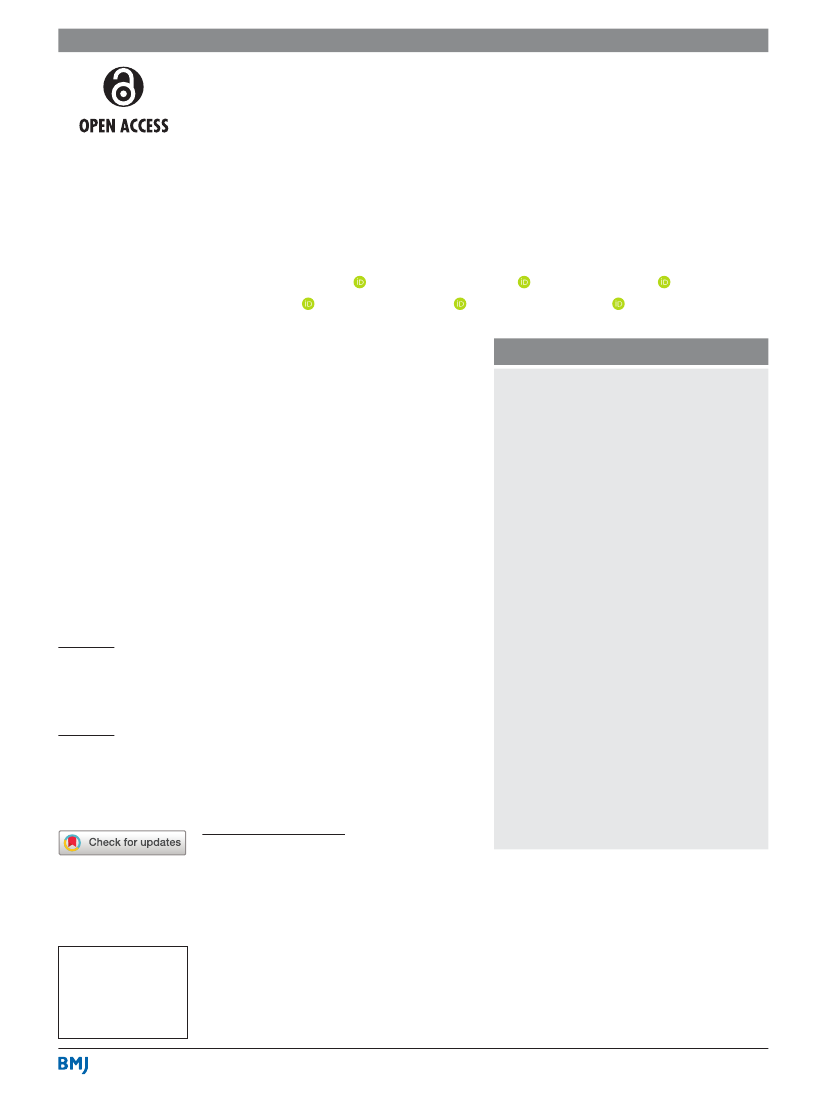
Workplace
Occup Environ Med: first published as 10.1136/oemed-2020-106554 on 9 September 2020. Downloaded from
http://oem.bmj.com/
on September 10, 2020 at National Institute of
Occupational Health - DNLA. Protected by copyright.
ORIGINAL RESEARCH
Associations between physical and psychosocial work
environment factors and sickness absence incidence
depend on the lengths of the sickness absence
episodes: a prospective study of 27 678
Danish employees
Sannie Vester Thorsen ,
1
Mari-Ann Flyvholm ,
1
Jacob Pedersen
Ute Bültmann ,
1,2
Lars L Andersen ,
3
Jakob Bue Bjorner
1,4,5
►
Additional material is
published online only. To view
please visit the journal online
(http://dx.doi.org/10.1136/
oemed-2020-106554).
,
1
ABSTRACT
Objectives
This study examined if the association
between work environment factors and sickness absence
(SA) depended on the inclusion or exclusion of short-
term SA episodes.
1
Analysis and Data, National
Methods
We linked the ’Work Environment and Health
Research Centre for the Working
in Denmark’ survey with the ’Danish Register of Work
Environment, Copenhagen,
Absences’ (n=27 678). Using covariate adjusted Cox
Denmark
2
regression, we examined the associations between work
Health Sciences, Community
and Occupational Medicine,
environment factors and SA by changing the cut-off
University of Groningen,
points for the length of the SA episodes, for example,
Groningen, Netherlands
episodes ≥1 day, ≥6 days and ≥21 days. We examined
3
Musculoskeletal disorders and
three physical work environment factors: ’Back bend
physical workloads, National
Research Centre for the Working
or twisted’, ’Lifting or carrying’, ’Wet hands’ and three
Environment, Copenhagen,
psychosocial work environment factors: ’Poor influence’,
Denmark
’Role conflicts’ and ’Bullying’.
4
QualityMetric, Johnston, Rhode
Results
’Back bend or twisted’ and ’Lifting or carrying’
Island, USA
5
had small significant HRs for SA episodes ≥1 day and
Department of Public Health,
University of Copenhagen,
large and highly significant HRs for SA episodes ≥6 days
Copenhagen, Denmark
and ≥21 days. ’Wet hands’ had small significant HRs
for SA episodes ≥1 day for both sexes and large and
Correspondence to
highly significant HR for ≥6 days for women. HRs of all
Dr Sannie Vester Thorsen,
Analysis and Data, The National
three psychosocial factors were highly significant for SA
Research Centre of the Working
episodes ≥1 day and ≥6 days for both sexes, and ’Poor
Environment, Copenhagen DK-
influence’ and ’Role conflicts’ were significant for SA
2100, Denmark; [email protected]
episodes ≥21 days for women.
Conclusions
The physical work factors had higher
Received 18 March 2020
associations with SA when SA episodes of 1–5 days
Revised 16 July 2020
Accepted 25 July 2020
were excluded and focus was on SA episodes ≥6 days.
The psychosocial work factors were strongly associated
with SA both with and without SA episodes of 1–5 days
included in the analyses.
Key messages
What is already known about this subject?
►
Poor physical and poor psychosocial work
environment factors are associated with long-
term sickness absence from work.
►
Short-term sickness absence (1–5 days)
constitutes a considerable part of the total
sickness absence from work.
What are the new findings?
►
Physical work environment factors ‘Back bend
or twisted’ and ‘Carrying and lifting’ were
strongly associated with sickness absence
of ≥6 days for both men and women, but
the inclusion of short-term sickness absence
episodes (1–5 days) deflated the association.
►
The psychosocial work environment factors
‘Role conflict’ and ‘Bullying’ were strongly
associated with sickness absence of ≥6 days
for both men and women. Including short-term
sickness absence episodes of 1–5 days only
slightly deflated the association.
How might this impact on policy or clinical
practice in the foreseeable future?
►
Work environment interventions that reduce
strenuous physical work may reduce sickness
absence episodes of ≥6 days. Work environment
interventions that improve different aspects
of the psychosocial work environment may be
important in the prevention of sickness absence
of all lengths.
such as low influence,
4 5
low decision authority,
6 7
role conflicts
3 5 8
and exposure to bullying
9
have
been associated with long-term SA in several
studies. Physical work environment factors such
as excessive ergonomic exposures (bending and
twisting of neck or back, lifting and carrying, squat-
ting and kneeling, etc) and heavy physical workload
have consistently been associated with long-term
SA among men and women.
10–12
Exposure of the
hands to wet work has been associated with long-
term SA in women.
13
1
© Author(s) (or their
employer(s)) 2020. Re-use
permitted under CC BY-NC. No
commercial re-use. See rights
and permissions. Published
by BMJ.
To cite:
Thorsen SV,
Flyvholm M-A,
Pedersen J,
et al.
Occup Environ Med
Epub
ahead of print: [please include
Day Month Year]. doi:10.1136/
oemed-2020-106554
BACKGROUND
In Denmark, 3.6% of all work hours are lost due
to sickness absence (SA).
1
The expense of SA bene-
fits alone exceeds 1.3 billion euro per year
2
not
counting the additional cost of lost productivity and
healthcare expenses. Knowledge about the associa-
tion between work environment factors and SA is
a prerequisite for reducing SA through preventive
efforts.
Poor work environment is associated with long-
term SA.
3
Psychosocial work environment factors
Thorsen SV,
et al. Occup Environ Med
2020;0:1–8. doi:10.1136/oemed-2020-106554